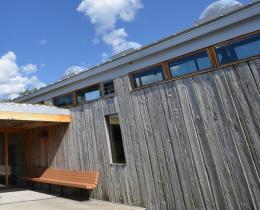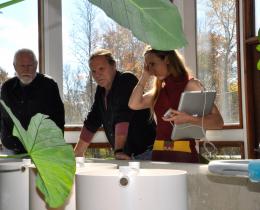Omega: What is "pattern mind" and how is it different from other methods of viewing the world?
Joel: Usually we look around and see “things”—buildings, furniture, people, trees, a dog, clouds—the obvious material beings of the world. But we rarely see life. Life is the exchanges between all of these things. The atmosphere rushing in and out of your lungs, your heart pumping blood around your body to nourish and cleanse each of your cells. The trees taking water and nutrients from beneath the ground and sending it into the air to seed the clouds while turning sunlight into sugars to nourish the dark earth. Buildings have people, money, and resources streaming in and out of them, too. This is the life of our living world and it can only be seen and understood by seeing the patterns. This is the the eye of the tracker, or the martial artist, or the acupuncturist. You are using it right now, reading these tracks of my words to see the movements of my thoughts, invisible on the page.
Omega: What does viewing the world through this lens reveal about the way living systems are organized?
Joel: Everything in this living creation organizes as nested systems or communities. This is true for organisms and organizations, economies and ecosystems. When we focus on the structures of these systems we see only half of the picture. It is how they work, interact, relate, and live that matters. It is the pattern of their interweaving dance that reveals not only they how they work, but what they need to develop further, to fully bloom.
Omega: How can this be used to establish a better relationship between humanity and the rest of the natural world?
Joel: All living beings are constantly growing and developing from phase to phase. It is very easy to get stuck in the familiar and turn a comfortable groove into a limiting rut. This is as true for a forest as it is for individuals, companies, governments, and societies. Being able to read where a system is allows us to see the tiny changes, the strategic disturbances that would open up the space to evolve to the next level. Native people used fire to regenerate many ecosystems. In our lives our experiences often make us question our beliefs. It is like finding a door to rooms in our house we have never seen—a new perspective that changes everything and opens opportunities we never considered.
Omega: How does "pattern mind" intersect with permaculture design?
Joel: Permaculture design begins with carefully observing the energies moving through a system—sun, wind, money, people, water—to understand its workings. Once you understand the pattern, you can see the smallest change you can make to enrich and develop the system. What is being designed is not so much what goes where, but relationships. How do we create exchanges that lead to greater health and greater yields? Permaculture design is based on principles of how our living world works. It can be applied to shifting any system and designing any change effort, from the development of a piece of land to transforming our human community from being despoilers of nature back to our role as acupuncturists of nature. It is about finding what Gregory Bateson called "the difference that makes a difference." The trick lies in seeing it.



